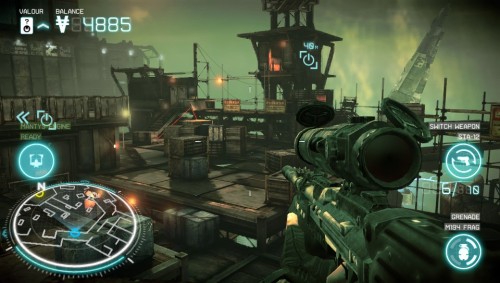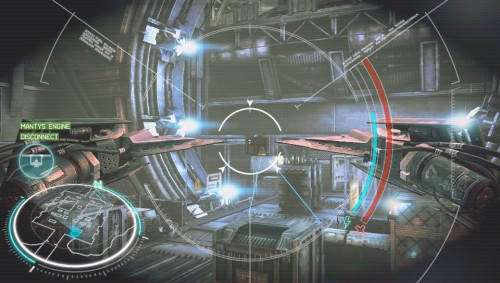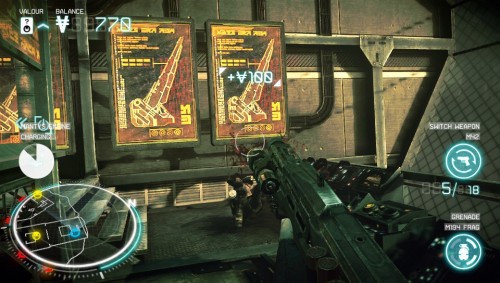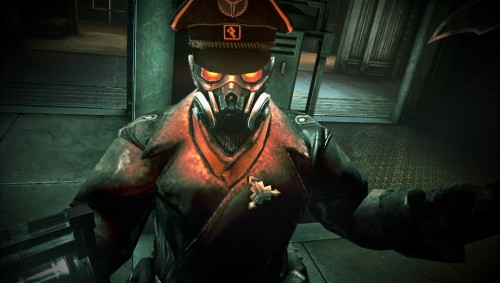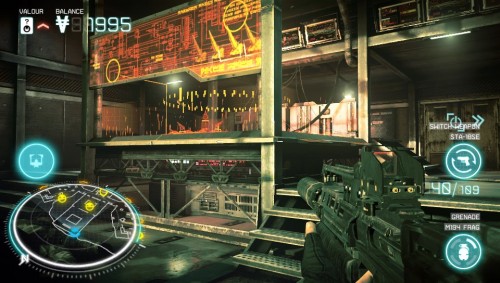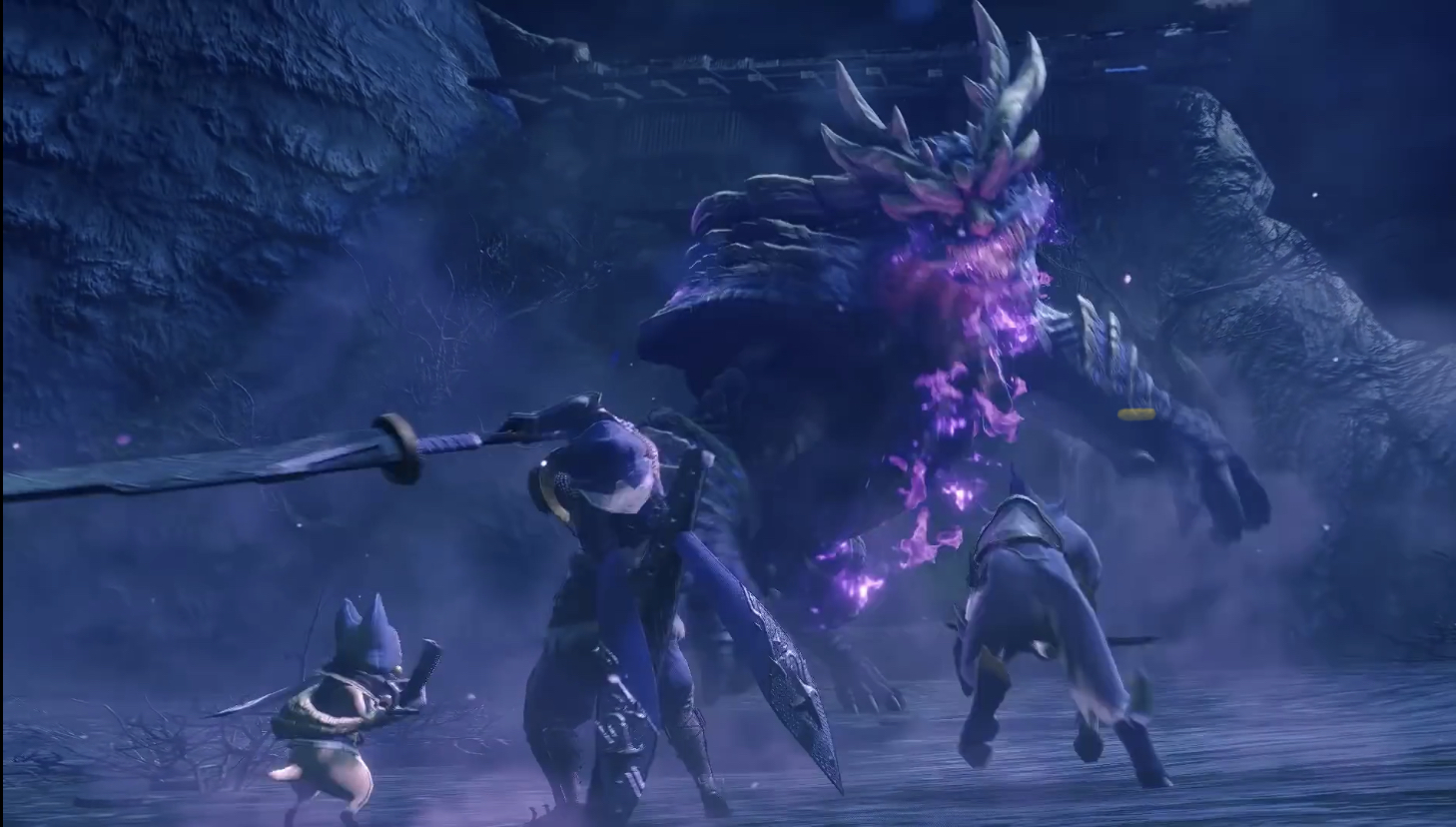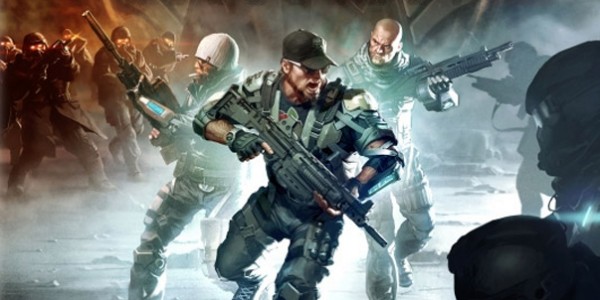
Rarely is the transition from home consoles to portable devices ever smooth, and too often is the end result weighed down by the stigma of “why did they bother?”. Seriously. More often not, attempts to strip console-like gaming formula down to something that works on a portable are disastrous, resulting in a watered down, lukewarm porridge of poor man’s console gaming with few, if any, positive contributions of its own.
Sometimes developers get it right. More simplistic formulas, like Super Mario Bros, make the move pretty easily. I attribute this to the processing power of modern portable platforms long having leapfrogged over the hardware limitations where these titles originated, lessening and in many cases outright removing the unfortunate necessity to scale down the design. And I think in today’s world of gaming, with platforms like the PlayStation Vita, high end iOS, and to a lesser extent the 3DS, we’re seeing that bridge between console and portable-like gaming experience built with stronger foundations. We’re not quite all the way there, but games like Resident Evil: Revelations and Uncharted: Golden Abyss make a compelling case for how even with a stripped down, compartmentalised “portable” design, these games run almost toe-to-toe with their bigger console brethren.
And though we’re still a couple of months out of release, spending a little time with Killzone: Mercenary for PlayStation Vita has me believe that it too will showcase just how far we’ve come in making that console-like gameplay formula believable, and most importantly fun, in the palms of your hands.
While mainline console titles tend to focus on the big series money shots, portable spin-offs steer towards side stories and “behind the scenes” narrative arcs, covering the adventures of otherwise lesser, unknown characters and accomplishments that befall them. Killzone: Mercenary is no different. Set sometime after the very original Killzone, Mercenary shows the perspective of one Arran Danner, a killer-for-hire with nothing to lose. Okay, maybe has plenty to lose, but my demo didn’t beat around the bush with melodramatic nonsense. Danner is simply a mercenary, a damn good one at that, and there’s a big ol’ Helghast war going on that calls for his natural talent of being able to shoot bad dudes in the head. Yes, just like previous Killzone titles, you will shoot the guy, and for the first time in Killzone history that “guy” might ISA soldiers. Supposedly, Mercenary will take this gruff soldier through many major set pieces across Killzone 2 and Killzone 3, showing a different side of the fence as Danner takes whatever contracts he can get, including Helghast.
Though I might be mistaken, my demo seemed to take place just prior to the introductory Corinth River landing sequence from Killzone 2, where Alpha Squad were thrown into the Helghan bloodbath, the war at boiling point. You might remember the Helghast arc cannons electro-frying ships out of the sky. Well, in Mercenary, it was my job to secretly glide in, squirrel suit style, and hack their mainframes to hand wireless control over to the ISA cruisers. You’ve probably seen this mission introduction in one of the many Mercenary trailers floating around.
What immediately jumped out at me about Killzone: Mercenary is the same thing that jumps out from every Killzone: the graphics. The series has long held a tradition of pushing Sony hardware to breaking point, showcasing both engine technical and artistic vision mastery, and Mercenary is really no different. It obviously doesn’t look as mind blowing as Killzone 2 or Killsone 3, but this is a game on the Vita, not the PlayStation 3, and still looks absolutely marvellous. I’m not sure if it’s running native or slightly sub-native resolution like Golden Abyss (the cynic in me says it is), but the image quality is both sharp and clear, textures painted with just the right amount of detail to show off that OLED screen, and some form of anti-aliasing (post, maybe) cleaning up jagged edges in motion. For whatever reason these aliased edges are quite prominent in the screen captures I took, but in motion those jaggies are hard to find.
There’s a lot of brown and grey, of course. This is Killzone after all. But it’s nice, cohesive brown and grey, that patented Killzone art style working magic on the Vita hardware. In fact, Killzone‘s artistic history might be a perfect fit, industrial and sci-fi gothic architecture making for hard edges and somewhat limited polygons in the geometry. It’s an excellent choice in the same way Resident Evil: Revelations‘ ship halls and simplistic rooms played nice with the 3DS hardware. It allows the game to look good and believable as part of the Killzone universe, while also keeping the framerate above “unplayable”. This was the second thing that I noticed; early on, Mercenary‘s framerate is really very good. Whether I was standing alone in a control room, or blasting Helghast dudes down corridors, the framerate seemed very stable, aiding the responsiveness of the controls and avoiding the choppy problems of Golden Abyss.
It wasn’t until the tail end of the demo that the framerate seemed to hit a snag, opening up the stage with a greater enemy count and larger zone to fight in. This isn’t unusual; bigger environment, more dudes to shoot, and you’re stressing the system. During this sequence I also got a few framerate hitches, the game briefly pausing after each couple of kills. I’ll give Guerrilla Cambridge the benefit of the doubt as these problems are common in preview builds, and figure the hitches will be ironed out come launch, but a fix for the framerate dips is up in the air. I’m not the kind of gamer who needs a rock solid 60fps in every game I play, I just want stability. For most of the level I played I got that stability, but it’s a shame it crumbled away during the climax. Fingers crossed optimisation works its magic.
Mechanically Mercenary seems to float somewhere between Killzone 2 and Killzone 3. To the game’s credit, it totally avoids that gross squishy, floaty feeling gunplay so often succumbs to in portable titles, where precision of shots takes a back seat to gigantic hitboxes. Gunplay actually feels really responsive and precise, weapons packing a meaty punch (just as they should for the Killzone series) and hit feedback satisfyingly indicating where you’ve landed your shots. This isn’t the kind of game where the headshot hitbox seems to be the size of a room. It’s clean, precise, and in turn all the more satisfying whenever you land them. And provides more evidence that Mercenary can play like a proper shooter on a portable.
Encounters themselves were a mixed bag. Look, the Vita is no PlayStation 3, so you’re not going to get that Killzone 2/3 AI complexity nor even the AI count in any single encounter. If there was any one part of Mercenary that seemed distinctly downsized for a portable, this would be it. Zones are smaller, encounters lesser in their dudes-to-shoot ratio, and the AI nowhere near as satisfyingly aggressive and tricky as the console series. But that’s okay, because encounters also flow fast. Mercenary didn’t drag its heels, quickly shepherding me off to a new zone and new encounter to fight, even if that encounter was only made up of two or three Helghast. There was plenty of “press switch, hack that, defend against wave” style gameplay setting up each objective and encounter, but keeping the pacing as fast as this throughout the entire game will help alleviate any worries of repetition. Things like security cameras, easy to spot and taken out with a single shot, do a decent job of keeping your attention and you shooting something, as triggering them will call in a small wave of support units. Mercenary at least recognised people are playing to shoot stuff as often as possible, and does what it can to support this.
Mercenary also makes a big deal out of the fact you’re a…you know…mercenary, a pushes this into a load-out and economy system. At times Mercenary actually feels a bit like a multiplayer shooter, for better or worse. Doing stuff, like shooting people in the head, taking out cameras, melee kills, and what have you earn you dollars to be spent on weapon crates scattered around each level. Think like Resent Evil 4‘s merchant. Instead of scavenging your goods, you’ll use the money earned to buy the weapons you want to use, customising your single player load out of primary and secondary weapons, as well as extra equipment, to suit your play style. While I thought this idea was pretty cool, and look forward to remixing levels with different weapons, the abundance of economy notifications did seem way over the top. It’s that kind of box ticking, carrot-on-a-stick XP stuff, numbers popping on the screen any time you do anything. I get that some players out there love this kind of “+500 good job soldier!” back-patting every time they get a kill, but it’s a little excessive for my taste. The simple on-screen economy tally is enough.
Controls are the only area I’m really not sure on with Killzone: Mercenary. This is where that Killzone 2/Killzone 3 in-between comes into play. Aiming isn’t quite as responsive as Killzone 3‘s Call of Duty-like controls, nor is it as heavy and sluggish as Killzone 2. But I’m not sure it’s the better of either. The dual analogue sticks of the Vita have the potential to be a go-to point for console-like controls on a portable, but nothing I could do (outside of sticking with it) removed the feeling that something was…off. Like the analogue sensitive was either too high or low, input lag was impacting responsiveness, or the analogue acceleration while turning was all over the place. The Killzone fanbase seems heavily divided in which game has the better controls, so I’m not sure how Mercenary will fair. Perhaps I just need to spend more time with it, and further tweak the X/Y sensitivity.
Touch controls are a take-it-or-leave-it kind of thing, and I could see them equally divisive among fans. Really, there’s no reason I should be swiping the screen to perform a QTE melee kill when I already pressed triangle to initiate said kill. But, at the same time, it’s quick and easy to do. Mercenary does seem to push the touch screen usage a big more than I expected. During my mission, a hacking mini-game had me matching up fragmented icons, simply touching the correct display. But touch controls are also used in the thick of combat. Next to primary and secondary weapons, Danner can use bonus equipment, like a pilotable stealth drone and heat seeking rocket launcher. While the former is manipulated via standard controls, the latter automates locking on during combat, and requires you touch highlighted enemies to fire. Speedy reflexes mean you can juggle standard combat play while launching a barrage of homing missiles, but it can get a bit fiddly touching across the screen mid battle just to use your special equipment. This is probably less of an issue for single player, where cheesing AI is a less of a big deal than fighting actual people. The multiplayer will be the deciding factor in whether or not people like these touch-based weapons.
All in all, I came away from Killzone: Mercenary with a positive impression. It gets the most important part right: the feel and satisfaction of shooting, which will provide essential framework for ensuring both the campaign and the multiplayer (that was sadly not part of the preview) have good things going for them. With the outstanding presentation the series is known for, and what is looking like a fully feature packed package both for solo and multi, Mercenary is ticking all the right boxes for what I think the most hardened Killzone fan would want from a portable game.
I’m still not sure about the controls, but again, adjustment over time is something to consider. And the framerate dips concern me, but it’s impossible to say how that will hold up until I’m playing the final build. If you want to make my negatives into a positive, consider that almost all of my qualms can be ironed out in the last few months of development, and none are tragically game breaking problems. Time will tell.
Killzone: Mercenary launches exclusively on PlayStation Vita in early September. We’ll have more on the game come release.

